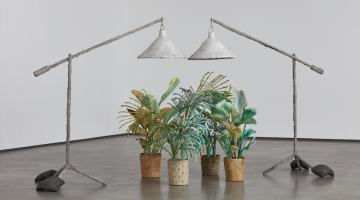The recent William Powhida show “Bill by Bill” at Charlie James Gallery in LA acts as both survey and critique of certain neo-formalist trends observed by the artist as the token objects of the proliferating art fair. Once a rare special event, art fairs have come to dominate the art market to an unprecedented extent, wherein a sort of new Académie has emerged dictating certain trends and aesthetics over others. It’s unsurprising that in the art fair context, where passers by must be enticed to purchase on the spot, formalism has won out over the conceptual. At the fair, context be damned, to see had better be enough to buy.

Mirror/steel sculpture: Mirror, nickel-plated drywall studs
48 x 48 x 30 inches
2013. Courtesy of the gallery.

Crate and Coyote: Wood crate, coyote, pink packing peanuts
19 x 65 x 27.5 inches
2013. Courtesy of the gallery.
Powhida displays the work as a catalog, with hand-painted accompanying “authenticity cards” that speak to the formalist dogma represented by each piece. Imagine a sort of contemporary art roast, where the resounding tropes of neo-formalism are called on their naked ambition and coy branding. All the familiar faces are here; from “A Post Minimalism” (“Three Colums on base”), and “A Neo Modernism” (“Sculpture”), to “Some Shiny Objects” (“Mirror/Steel sculpture”) and “A Taxidermied Animal” (“Crate and Coyote”), the show does a superb job in identifying enough art world trends that it could serve as the primer for a lower division art history course—Art 103: Survey of Contemporary Consumer Driven Trends. The whole thing comes off farcical, an almost “Colbert Report” on the art market and this tongue in cheek approach is crucial to Pwhida being able to pull it off, as is his skilled and attentive execution in each piece—it may be a joke, but it doesn’t look like one.
After several decades of the dominance of the conceptual in contemporary art, where formal and medium-specific concerns were secondary to the loftier ambitions of “dialogue”, contemporary artists have begun to re-embrace formalist concerns again. Whether these are purely commercially motivations, or “pure” artistic pursuits, is ultimately inconsequential. Art has always been an industry available to the highest bidder, the difference today being we’re all allowed in the market, we are all kings. If art fairs have democratized the art buying experience, we can see these emergent trends as the will of the people. While there’s no guarantee that a populist approach will make better art, just look at Hollywood’s current state of 80s remakes and comic book franchises’ for an example of how it can go wrong, it does offer artists unprecedented access to an audience, as well as the opportunity to make something that will be good enough even without the lengthy didactics we have come to associate with the contemporary art experience.
For more information visit here.
-Contributed by Kathryn McKinney




